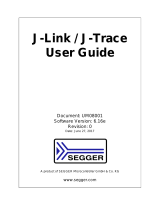
Nexus Interface API
Reference Manual
Table of Contents RM004502-0506
iv
nxt_Status nx_ReadMem (nxt_Handle * handle, const int map, const int
accessPriority, const nxvt_Address addr, const size_t numBytes,
const int accessSize, void ** bytesRead) . . . . . . . . . . . . . . . . . . . 17
nxt_Status nx_SetEvent (nxt_Handle * handle, const nxt_SetEvent *
setEvent) . . . . . . . . . . . . . . . . . . . . . . . . . . . . . . . . . . . . . . . . . . . . 18
nxt_Status nx_WriteMem (nxt_Handle * handle, const int map, const int
accessPriority, const nxvt_Address addr, const size_t numBytes,
const int accessSize, const void * bytesToWrite) . . . . . . . . . . . . . 19
Appendix. . . . . . . . . . . . . . . . . . . . . . . . . . . . . . . . . . . . . . . . . . . . . . . . . . . . . 21
Glossary . . . . . . . . . . . . . . . . . . . . . . . . . . . . . . . . . . . . . . . . . . . . . . . . . . . 21
Nexus Vendor Extensions Reference . . . . . . . . . . . . . . . . . . . . . . . . . . . . 21
Defines . . . . . . . . . . . . . . . . . . . . . . . . . . . . . . . . . . . . . . . . . . . . . . . . 21
Typedefs . . . . . . . . . . . . . . . . . . . . . . . . . . . . . . . . . . . . . . . . . . . . . . . 23
Enumerations . . . . . . . . . . . . . . . . . . . . . . . . . . . . . . . . . . . . . . . . . . . 23
Structures . . . . . . . . . . . . . . . . . . . . . . . . . . . . . . . . . . . . . . . . . . . . . . 28
nxvt_ExtProgramErase . . . . . . . . . . . . . . . . . . . . . . . . . . . . . . . . . . . . 30
nxvt_ExtProgramSet . . . . . . . . . . . . . . . . . . . . . . . . . . . . . . . . . . . . . . 32
nxvt_TargetConfiguration . . . . . . . . . . . . . . . . . . . . . . . . . . . . . . . . . . 34
nxvt_IntProgramErase . . . . . . . . . . . . . . . . . . . . . . . . . . . . . . . . . . . . . 38
nxvt_IntProgramSet . . . . . . . . . . . . . . . . . . . . . . . . . . . . . . . . . . . . . . 39
nxvt_Registers . . . . . . . . . . . . . . . . . . . . . . . . . . . . . . . . . . . . . . . . . . . 40
nxvt_VendorDefinedCtrlData . . . . . . . . . . . . . . . . . . . . . . . . . . . . . . . 40
nxvt_VendorDefinedTargetSpec . . . . . . . . . . . . . . . . . . . . . . . . . . . . . 45
nxvt_VendorDefinedBasicSetEvent . . . . . . . . . . . . . . . . . . . . . . . . . . 45
Standard Registers Access . . . . . . . . . . . . . . . . . . . . . . . . . . . . . . . . . . . . . 46
Z8 Encore! . . . . . . . . . . . . . . . . . . . . . . . . . . . . . . . . . . . . . . . . . . . . . . 46
eZ80Acclaim! . . . . . . . . . . . . . . . . . . . . . . . . . . . . . . . . . . . . . . . . . . . 48
ZNEO . . . . . . . . . . . . . . . . . . . . . . . . . . . . . . . . . . . . . . . . . . . . . . . . . 50






















